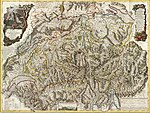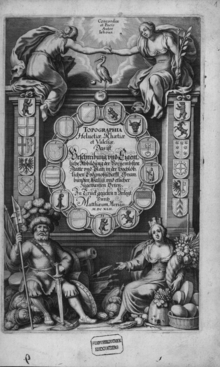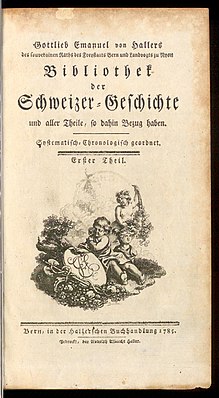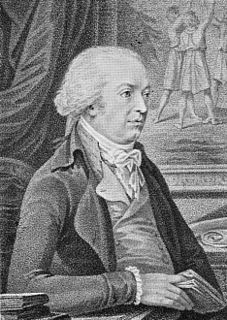
Johannes von Müller was a Swiss historian.
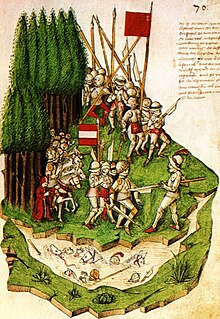
The Battle of Morgarten took place on 15 November 1315, when troops of Schwyz, supported by their allies of Uri and Unterwalden, ambushed an Austrian army under the command of Leopold I, Duke of Austria on the shores of Lake Ägeri, in the territory of Schwyz.

The national flag of Switzerland displays a white cross in the centre of a square red field. The white cross is known as the Swiss cross or the federal cross. Its arms are equilateral, and their ratio of length to width is 7:6. The size of the cross in relation to the field was set in 2017 as 5:8.
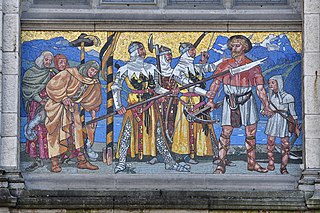
William Tell is a folk hero of Switzerland. According to the legend, Tell was an expert mountain climber and marksman with a crossbow who assassinated Albrecht Gessler, a tyrannical reeve of the Austrian dukes of the House of Habsburg positioned in Altdorf, in the canton of Uri. Tell's defiance and tyrannicide encouraged the population to open rebellion and a pact against the foreign rulers with neighbouring Schwyz and Unterwalden, marking the foundation of the Swiss Confederacy. Tell was considered the father of the Swiss Confederacy.

The Old Swiss Confederacy began as a late medieval alliance between the communities of the valleys in the Central Alps, at the time part of the Holy Roman Empire, to facilitate the management of common interests such as free trade and to ensure the peace along the important trade routes through the mountains. The Hohenstaufen emperors had granted these valleys reichsfrei status in the early 13th century. As reichsfrei regions, the cantons of Uri, Schwyz, and Unterwalden were under the direct authority of the emperor without any intermediate liege lords and thus were largely autonomous.

Eidgenossenschaft is a German word specific to the political history of Switzerland. It means "oath commonwealth" or "oath alliance" in reference to the "eternal pacts" formed between the Eight Cantons of the Old Swiss Confederacy of the late medieval period, most notably in Swiss historiography being the Rütlischwur between the three founding cantons Uri, Schwyz and Unterwalden, traditionally dated to 1307. In modern usage, it is the German term used as equivalent with "Confederation" in the official name of Switzerland, Schweizerische Eidgenossenschaft, rendered Confédération and Confederazione in French and Italian, respectively. The related adjective, eidgenössisch, officially translated as Swiss federal, is used in the name of organisations, for example the Eidgenössische Technische Hochschule, Swiss Federal Institute of Technology. The term Eidgenosse refers to the individual members of the Eidgenossenschaft. It is attested as early as 1315, in the Pact of Brunnen, referring to the cantons of Uri, Schwyz and Unterwalden. The abstract noun Eidgenossenschaft is attested in the 15th century. In modern usage, Eidgenosse is sometimes used for "Swiss citizen", especially for those citizens of purely Swiss origin, not immigrated.
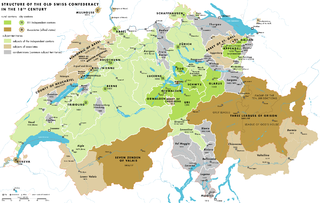
The early modern history of the Old Swiss Confederacy and its constituent Thirteen Cantons encompasses the time of the Thirty Years' War (1618–1648) until the French invasion of 1798.

The coat of arms of the Swiss Confederation shows the same white-on-red cross as the flag of Switzerland, but on a heraldic shield instead of the square field.

The Treaty of Basel of 22 September 1499 was an armistice following the Battle of Dornach, concluding the Swabian War, fought between the Swabian League and the Old Swiss Confederacy.

The Rütlischwur is the legendary oath taken at the foundation of the Old Swiss Confederacy by the representatives of the three founding cantons, Uri, Schwyz and Unterwalden, It is named after the site of the oath taking, the Rütli, a meadow above Lake Uri near Seelisberg. Recorded in Swiss historiography from the 15th century, the oath is notably featured in the 19th century play William Tell by Friedrich Schiller.

The Old Swiss Confederacy or Swiss Confederacy was a loose confederation of independent small states, initially within the Holy Roman Empire. It is the precursor of the modern state of Switzerland.

The English name of Switzerland is a compound containing Switzer, an obsolete term for the Swiss, which was in use during the 16th to 19th centuries. The English adjective Swiss is a loan from French Suisse, also in use since the 16th century.
Burkhard VII. Münch was a knight and life peer, a renowned late member of the Landskron branch of the Münch family. His reputation rests primarily on his death at the Battle of St. Jakob an der Birs. Burkhard's death spelled the end of the family Münch of Landskron, which ended completely when his brother Johann IX. died in 1461.
The Pact of Brunnen is a historical treaty between the cantons of Uri, Schwyz, Unterwalden, concluded in Brunnen on 9 December 1315.

Albrecht von Bonstetten was a Swiss humanist of the later 15th century. A member of the baronial von Bonstetten family, he entered Einsiedeln Abbey at a young age, and after studies in Fribourg and Basel he returned to Einsiedeln and was made deacon in 1469. He studied canon law at Pavia and was ordained a priest in 1474, and he received the title of doctor utriusque iuris from Emperor Maximilian in 1498.

Wilhelm Oechsli was a Swiss historian.
In legend and in the early historiography of Switzerland there is an account of a migration of a population of Swedes and Frisians settling in the Swiss Alps, specifically in Schwyz and in Hasli (Schwedensage).
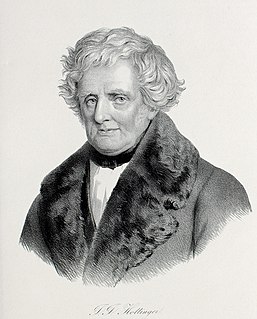
Johann Jakob Hottinger was a Swiss historian. He was a great-grandson of philologist Johann Heinrich Hottinger (1620–1667).

Johannes Dierauer was a Swiss historian and librarian. He taught history classes at the Cantonal School in St. Gallen from 1868 to 1907 and, from 1874 to 1920, served as the head of the City Library of St. Gallen.

The Stauffacherin is a Swiss legendary figure. According to Swiss folklore, she was the wife of Werner Stauffacher, the Landammann of the Canton of Schwyz and a founding father of the Old Swiss Confederacy. She was depicted in Friedrich Schiller's 1804 play William Tell as an advisor to her husband, advocating for Swiss independence from Habsburg rule. The image of the Stauffacherin, often viewed as the feminine counterpart to Wilhelm Tell, has become a symbol for Swiss national pride, democracy, and women's suffrage.
